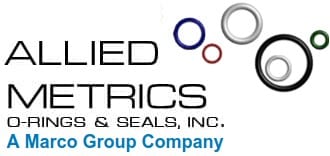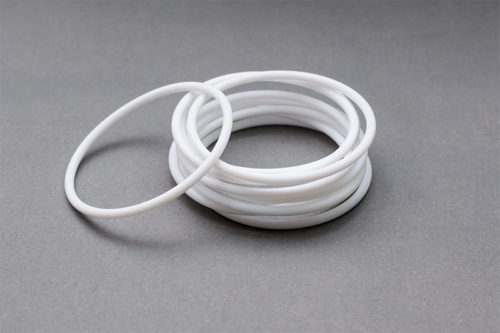Better known by the brand name Teflon, polytetrafluoroethylene (PTFE) provides a nonstick surface to cookware, nail polish, hairstyling tools, fabric/carpet treatment, and windshield wiper blades. However, manufacturers are seeing increased benefits from using PTFE as a way to manufacture quality O-rings. O-rings built using PTFE provide superior thermal and chemical insulation, and they can resist friction and water as well.
PTFE
PTFE is a synthetic polymer derived from chemical bonding between carbon and fluorine, taking advantage of free radicals’ tendency to polymerize with tetrafluoroethylene. This material was accidentally discovered in 1938, when DuPont chemist Roy J. Plunkett attempted to create a new type of refrigerant, and mixed these materials together without knowing the reaction that it would cause.
Teflon
Kinetic Chemicals, a partnership company between DuPont and General Motors, trademarked PTFE under the brand name Teflon in 1945. In essence, Teflon is PTFE. However, PTFE is also available under a variety of other brand names, such as:
- Daikin-Polyflon
- Fluon
- Dyneon
Properties
Several properties distinguish PTFE from other substances, including:
- Low friction coefficient: PTFE has the third lowest friction coefficient of any substance known to man, meaning that it’s really
- Functions at temperature extremes: Rated at 600 K, PTFE melts at 327ºC or 620ºF, and it also functions well at temperatures as low as −268ºC or −450ºF.
- Resists water: Water beads up on the surface of PTFE, meaning that surfaces treated with this material resist oxidation.
- Nonreactive: PTFE doesn’t react with the vast majority of corrosive substances, making it ideal for use in pipes, valves, seals, and O-rings.
PTFE’s High Temperature Range
The temperature range (-1,000F to +4,000F), nonreactivity, water resistance, and low friction properties of PTFE make it an ideal material to build O-rings for use in a wide variety of applications. These properties make PTFE O-rings an ideal choice for weather-resistant applications as well as applications involving electricity and thermal insulation.
Due to their density, PTFE O-rings are not “melt-formed”—instead, they are compressed and sintered to provide the necessary shape.
Teflon/PTFE Seals
O-rings made of PTFE are present in a wide variety of industrial applications that require seals that can stand adversity. PTFE O-rings appear in many applications that are exposed to the following risk factors:
| Top Applications | Mechanical Weaknesses |
|---|---|
|
|
Therefore, PTFE O-rings benefit applications such as:
- Mills, crushers, and grinders
- Pumps
- Stirring and agitator systems
- Transmissions and gear boxes
- Rotary or screw-type air compressors
- Machining tools
- Centrifuges
- Blower systems
Enhanced Mechanical Properties with Filled Grades
As shown in the table above, PTFE O-Rings have some mechanical vulnerabilities compared to other plastics. If needed, these properties can be enhanced by adding fillers, such as:
- Glass Fibers
- Carbon
- Graphite
- Molybdenum disulphide
- Bronze
“Filled” O-Rings maintain their excellent chemical and temperature resistance while fillers improve mechanical strength, stability, and wear resistance.
| Filler | Physical Form | Amount (% Weight) | Effect of Filler |
|---|---|---|---|
| Glass Fibers | Milled Fibers | Up to 40% (also in combination with graphite, MoS2, and carbon) |
|
| Carbon | Powder | Up to 35% (also in combination with graphite, bronze, and glass) |
|
| Carbon Fibers | Milled Fibers | Up to 30% |
|
| Graphite | Powder | Up to 25% (also in combination with glass, bronze, and carbon) |
|
| Bronze | Powder | Up to 60% (also in combination with carbon, graphite, and MoS2) |
|
| Molybdenum Disulfide (MoS2) | Powder | Up to 5% (also in combination with glass and bronze) |
|
| Stainless Steel | Powder | Up to 60% |
|
| Polymers | Powder | Up to 20% (also in combination with inorganic fillers) |
|
| Pigments | Powder | Up to 2% |
|
Quality PTFE O-Rings from Allied Metrics
With so many applications across so many industries, it’s easy to see why manufacturers turn to PTFE O-rings when they seek a quality sealing solution. You can find PTFE O-rings in such industries as:
- General manufacturing
- Medical device assembly
- Packaging
- Aerospace and automotive manufacturing
- Applications that meet FDA, USDA, and 3-A dairy requirements
If you would like to learn more about how to incorporate our PTFE O-rings in your next project, be sure to request a quote or contact us for more information.



